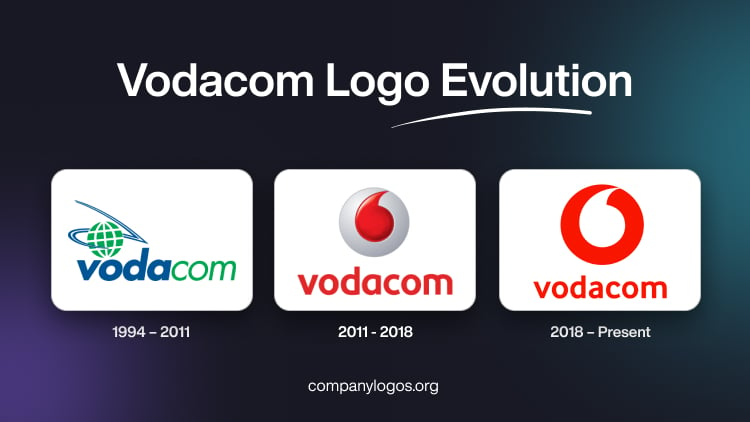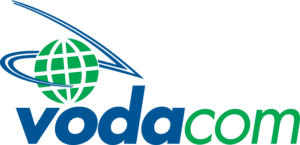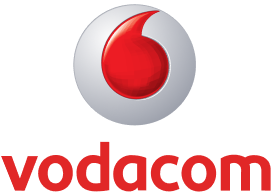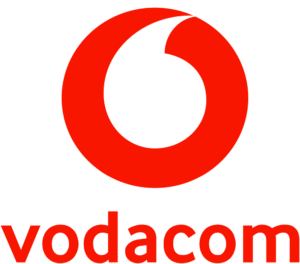
Vodacom is one of Africa’s leading telecommunications companies and a subsidiary of the global Vodafone company. Established in 1994, the evolution of its logo reflects both changes in corporate identity as well as shifts in the broader telecommunications landscape. Besides, it also shows the influence of its parent company, Vodafone. The article explores the evolution of the Vodacom logo since the establishment of the brand.
The Genesis of the Vodacom Logo (1994 – 2011)
When Vodacom was founded in 1994, its original logo featured a blue and green colour scheme. It symbolised trust, reliability, and growth – qualities that were essential for a new telecommunications provider in a rapidly liberalising South African market. The logo included the Vodacom name in a bold, modern font in lowercase, which is often accompanied by a stylised graphic element that represented connectivity and communication.
Besides, in the wordmark “vodacom”, “voda” appeared in a bold, deep blue colour, while “com” appeared in green. This branding was distinct and helped Vodacom establish itself as a household name during South Africa’s post-apartheid telecommunications boom.

(2011 – 2018)
On 1 April 2011, Vodacom officially unveiled a new logo variant that replaced its longstanding blue and green colours with the iconic red and white of Vodafone. This move aligned Vodacom visually with its global parent while retaining the Vodacom name. This became the representation of the first Vodafone subsidiary. The new logo introduced the Vodafone “speech mark” (often mistaken for a teardrop) as a central visual element. It symbolised conversation and connectivity. The wordmark in red lowercase was written using a modern typeface, and the overall look became cleaner and more dynamic. The font reflected the forward-looking approach of the company.

(2018 – Present)
In 2018, the Vodacom logo that continues to this day featured a flat, two-dimensional version of the speech mark. This change was designed to make the logo more adaptable for digital platforms and to give it an iconic status, similar to the Nike “swoosh”. The red colour was retained, but the font was further updated to enhance modernity and readability.

The Elements of the Vodacom Logo
Font
The font used to write the wordmark in the Vodacom logo is a clean, sans-serif typeface. The typeface is characterised by rounded edges, balanced proportions, and readability. It is designed to convey clarity, modernity, and approachability. In fact, the font is similar to fonts like Helvetica or Arial Rounded. This choice of typeface aligns with Vodacom’s identity as a reliable and forward-thinking telecommunications provider. The rounded elements in the font also give the brand a friendly and customer-oriented feel, and increase its appeal to a broad audience.
Colour
The Vodacom logo employs a red and white colour combination. The colour red, specifically a bold and crimson red, is chosen to evoke attributes such as energy, passion, confidence, and urgency. Besides, in branding, red often represents strength and action, which suits Vodacom’s role in fast-paced digital communication. The white colour in the logo is used as the surrounding background to enhance readability and create a clean, high-contrast look.
The History of Vodacom
The roots of Vodacom can be traced back to 1991, when South Africa began investigating the potential of mobile telecommunications. The government, after recognising the future of GSM technology, initiated a process to award two cellular licences to foster competition and ensure affordable, widespread service. The applicants were required to demonstrate how their technology choices would benefit South African industry and underserved communities.
In early 1993, Vodacom was established as a joint venture between Telkom (50%), Vodafone (35%), and Venfin (15%), linked to the Rupert family. Alan Knott-Craig, a Telkom executive, became Vodacom’s first CEO. The company was awarded one of the two licences, with MTN receiving the other. Vodacom launched its commercial mobile voice services on June 1, 1994, which coincided with South Africa’s first democratic elections. The company connected 10,000 customers on its first day and rapidly exceeded its initial growth projections. It reached 100,000 customers within five months and over three million users by 2000.
A key factor in Vodacom’s early success was its aggressive marketing, such as the “yebo gogo” campaign, and a focus on network quality and innovation. The company introduced prepaid services (Vodago) in 1996, which made mobile access more affordable and accessible.
Vodacom quickly expanded beyond South Africa and launched operations in Lesotho, Mozambique, the Democratic Republic of the Congo (DRC), and Tanzania. The company became known for pioneering new technologies, such as being the first in the world to launch prepaid internet access in 1998. It is also known for introducing 3G services in South Africa in 2004. Vodacom also made headlines for providing GSM coverage to Mount Kilimanjaro, then the highest point in the world with mobile coverage.
In 2008, Vodafone increased its stake in Vodacom to 64.5%, which prompted Telkom to spin off its remaining holding and list Vodacom on the Johannesburg Stock Exchange (JSE) in 2009. This period also saw Vodacom’s rebranding in 2011, wherein it switched its corporate colours from blue to red to align with Vodafone’s global identity.
Vodacom has maintained its position as South Africa’s leading mobile network, with a market share exceeding 40% and over 45 million users in the country alone. Across Africa, it serves more than 130 million customers and operates networks in Egypt, Tanzania, DRC, Mozambique, and Lesotho. Besides, it provides business services in over 32 countries.
The company has continued to innovate. For instance, it launched 4G in South Africa in 2012 and expanded its financial services offerings, especially using M-PESA. This is a mobile payments platform co-owned with Safaricom and is operational in several African countries. Vodacom’s leadership has included influential figures such as Alan Knott-Craig, Pieter Uys, and current CEO Shameel Joosub.
Vodacom remains active in mergers and acquisitions. However, a proposed merger with the fibre group Maziv was blocked by South African regulators in 2024. The company has stated it will not pursue further M&A deals for now.
Interesting Facts About Vodacom
- Vodacom launched one of Africa’s first GSM networks in South Africa in 1994, which coincided with the country’s transition to democracy. This made Vodacom a key player in expanding access to telecommunications for millions of South Africans.
- Vodacom’s network covers Mount Kilimanjaro, the highest point in the world with GSM network coverage. This showcases the company’s commitment to connecting even the most remote and challenging locations.
- As of 2024, Vodacom Group’s customer base surpassed 200 million people across Africa. Its networks cover a total population of more than 500 million.
- The Top Employers Institute ranked Vodacom as Africa’s number one employer in 2024.
- Vodacom, including its partnership with Safaricom, has over 73.5 million financial services customers across eight markets. Its mobile money platforms, such as M-Pesa and VodaPay, have brought millions into the formal financial system.
- Vodacom has rolled out nearly 9,000 4G sites across its markets and deployed over 1,300 deep rural low-cost sites in countries like the DRC, Tanzania, and Mozambique. This way, it has helped to bridge the digital divide.
- Vodacom is part of the consortium behind the 2Africa subsea cable, which is the world’s largest fibre-optic cable project that spans 45,000km and connects Europe, Africa, and Asia. The company is also collaborating with Vodafone and Amazon’s Project Kuiper to use low Earth orbit satellites for extending 4G and 5G coverage to rural Africa.
- In 2024, Vodacom was named South Africa’s Most Valuable Telecommunications Brand and was recognised for its innovative expansion into new geographies and services.
- Vodacom has launched numerous initiatives such as the Siyakha platform (offering zero-rated content for basic services), Mum & Baby (providing health information), and Connected Farmer (linking smallholder farmers to the commercial agriculture value chain). Its education programme has provided ICT equipment and connectivity to over 2,500 schools and trained more than 300,000 teachers.
- Vodacom has spent over R80 million on disaster relief in response to natural disasters across South Africa and has supported Black-owned entrepreneurs through franchise channel loans.
Finally
The Vodacom logo and its various iterations – from its original blue and green identity to the bold red speech mark – display the growth of the company from a national telecom upstart to a major player integrated into Vodafone’s global network. Each redesign has modernised the brand’s appearance and has reinforced its commitment to innovation and connectivity across Africa.